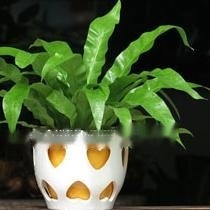
Chinese name: Bird's nest fern
Latin name: Asplenium nidus
Aliases: Nest fern, Shansu flower, Crown fern
Family: Fernidae
Genus: Pteridium
Distribution area: Southeast Asia, Australia, Hawaii, Indonesia and other places.
1. The shape of the bird's nest fern
The height of the bird's nest fern is about 80 cm to 100 cm. The root-like stem veins are erect, but stubby and woody. About two centimeters in diameter, dark brown, with scales at the front, the scales are broadly lanceolate and about one centimeter in length. The leaves are clustered, the petiole is 2 cm to 7 cm in length, and the diameter is about 7 mm. The color is dark brown, and it is woody. The lower part has semi-circular bumps. It has narrow wings, the base scales are broadly lanceolate, dark brown in color, and smooth upward. The leaves are broad-lanceolate, 75 cm to 98 cm in length, the front end is relatively sharp, the widest part in the middle is 6.5 cm to 8.5 cm, and gradually becomes narrow and elongated downward.
2. Habits of the bird's nest fern
The bird's nest fern is a relatively large shaded foliage plant. It is also hung indoors and has a tropical atmosphere. It is planted under tropical garden trees or rockeries. On the rocks, small potted plants are used to decorate bright living rooms, conference rooms, study rooms and bedrooms. Bird's nest ferns are found in many tropical regions. Domestic: China Taiwan, Guangdong, Guangxi, Hainan (Wuzhishan, Jianfengling), Yunnan (Jinping) and other places; foreign: East Africa, Japan (Honshu, Shikoku, Kyushu, Ryukyu), South Korea (Jeju Island), most of Southeast Asia tropical regions, Australia, etc. Bird's nest ferns are often epiphytic on tree trunks or rocks under forests in rain forests or monsoon forests. They like high temperature and humidity and are not resistant to strong light.
3. Cultivation of bird's nest fern
The cultivation of bird's nest fern can be carried out by division and spore propagation. For spore reproduction, first mix fine sand and humus soil in spring, sterilize at high temperature, put it into the seeding pot and flatten it, spread the mature spores evenly on the pot soil, and then immerse the pot in shallow water. Infiltration, make the pot soil fully moist, cover the glass to keep moisture, and place it in a warm and cool place, the spores can germinate in 7 to 10 days, and after about 1 month, green prothallus will grow, 3 A few months later, when it grows a few true leaves, it can be cultivated in pots.
Guess you like it
Snow White | Taxus | Rhododendron | Lavender | Mint |
Copper Coin Grass | Dracaena | Green Apple | Morning Glory | Mosquito Grass | Basil | Ingot Tree | African Jasmine | Sage | Bamboo Cypress | Bamboo | Penglai pine | Emerald | Duck palm wood | Bird's nest fern | Lobelia | Rush | Mushroom | Wildflower | Hornwort | Duckweed | Cattail | Cigu | Cress | Egg Fruit | >
![[Dog Training 5] The training method of pet dog dining etiquette](/static/img/12192/12192_1.jpg)




